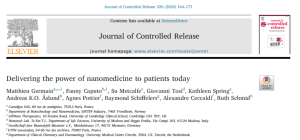IT_Version
Nanomedicine takes advantage of innovative nanotechnologies to face complex medical challenges, overcoming critical barriers in conventional medicine.
For decades, expectations on nanomedicines have grown, sometimes leading to overrated promises that support current critical opinions on the field. Some of the ETPN (European technology Platform on Nanomedicine) board members have recently published a position paper to debate some of the raised criticisms.
First of all, the ETPN working group has highlighted how nanomedicine has led to concrete results, like the creation of start-up companies and the production of several products entering clinical trials, even though some bottlenecks are still delaying nanomedicine efficient translation to clinics.
Up to now, the main fields of application of nanomedicine products have been cancer treatment and iron-replacement therapies (for example to treat some forms of iron-deficiency anemia). In particular, the 65% of the ongoing clinical trials are focussed on cancer applications, where the significance of nanotechnologies is related to the amelioration of treatments by reducing side effects and to the promotion of an early diagnosis.
Besides, significant achievements have been recently obtained by the production of lipid-based particles for drug delivery to treat central nervous system diseases. The ability of nanomedicine formulations to pass through the blood brain barrier has inspired multiple nanodrugs that have already obtained relevant preclinical results. In this framework, the NEVERMIND project coordinated by LABION researchers has proposed the creation of lipid based nanovectors, tailored to treat glioblastoma and Alzheimer’s disease (see more here).
In general, one of the main advantages of nanomedicines is the possibility to re-design and improve a generic nanotechnology-based platform for new functions, adapting a product for a new application without starting again from the beginning.
“.. one can adapt the product to new applications or subtypes of patients with the same disease, with better efficiency, and while keepimg some advantages inherent with the core particle itself. “
Outstanding results were also obtained for nanoparticles as imaging agents and from the application of nanomaterials as active therapeutic ingredients. As an example, nanoparticles have been used to limit the side effects of radiotherapy against solid tumors: the injection of nanoparticles in the solid tumor allows to increase the energy directed against the cancer cells inducing a more localized and effective treatment of cancer compared to the ioniozing radiation alone.
Still, the ETPN members have highlighted sono of the main current difficulties in clinical translation of nanomedicine, especially the lack of protocols and the lack of access to characterization facilities together with uncertainty of the regulatory framework. Regarding the latter, nanomedicine is officially regulated as small traditional drugs, but technical challenges exists in the application of pharmaceutical quality criteria to nanomedicine products.
ETPN works to help the application of nanotechnology in healthcare through the nanomedicine Translation HUB and other strategical initiatives in order to play a key role in shaping a cross-technology environment to design multidisciplinary medical solutions for the benefit of patients.
To read the complete paper: Delivering the power of nanomedicine to patients today. Journal of Controlled Release, Volume 326, 10 October 2020, Pages 164-171. https://doi.org/10.1016/j.jconrel.2020.07.007





